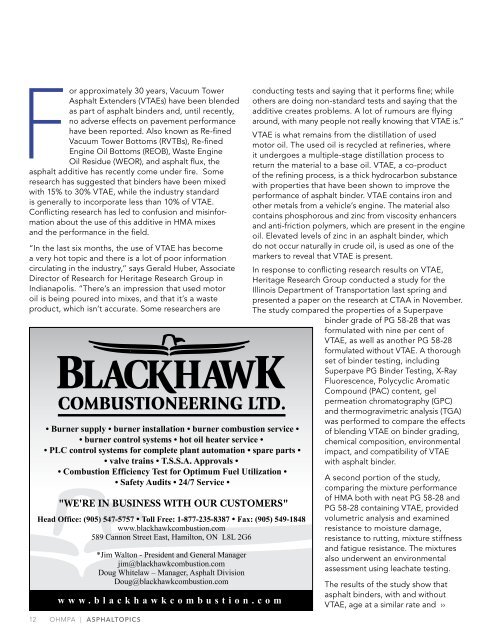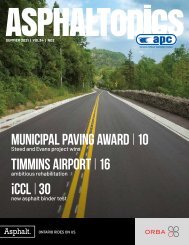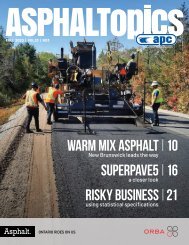ASPHALTopics | Summer 2014 | VOL 27 | NO3
You also want an ePaper? Increase the reach of your titles
YUMPU automatically turns print PDFs into web optimized ePapers that Google loves.
For approximately 30 years, Vacuum Tower<br />
Asphalt Extenders (VTAEs) have been blended<br />
as part of asphalt binders and, until recently,<br />
no adverse effects on pavement performance<br />
have been reported. Also known as Re-fined<br />
Vacuum Tower Bottoms (RVTBs), Re-fined<br />
Engine Oil Bottoms (REOB), Waste Engine<br />
Oil Residue (WEOR), and asphalt flux, the<br />
asphalt additive has recently come under fire. Some<br />
research has suggested that binders have been mixed<br />
with 15% to 30% VTAE, while the industry standard<br />
is generally to incorporate less than 10% of VTAE.<br />
Conflicting research has led to confusion and misinformation<br />
about the use of this additive in HMA mixes<br />
and the performance in the field.<br />
“In the last six months, the use of VTAE has become<br />
a very hot topic and there is a lot of poor information<br />
circulating in the industry,” says Gerald Huber, Associate<br />
Director of Research for Heritage Research Group in<br />
Indianapolis. “There’s an impression that used motor<br />
oil is being poured into mixes, and that it’s a waste<br />
product, which isn’t accurate. Some researchers are<br />
• Burner supply • burner installation • burner combustion service •<br />
• burner control systems • hot oil heater service •<br />
• PLC control systems for complete plant automation • spare parts •<br />
• valve trains • T.S.S.A. Approvals •<br />
• Combustion Efficiency Test for Optimum Fuel Utilization •<br />
• Safety Audits • 24/7 Service •<br />
"WE'RE IN BUSINESS WITH OUR CUSTOMERS"<br />
Head Office: (905) 547-5757 • Toll Free: 1-877-235-8387 • Fax: (905) 549-1848<br />
www.blackhawkcombustion.com<br />
589 Cannon Street East, Hamilton, ON L8L 2G6<br />
12 OHMPA | ASPHALTOPICS<br />
*Jim Walton - President and General Manager<br />
jim@blackhawkcombustion.com<br />
Doug Whitelaw – Manager, Asphalt Division<br />
Doug@blackhawkcombustion.com<br />
www .blackh awkcombusti on. com<br />
conducting tests and saying that it performs fine; while<br />
others are doing non-standard tests and saying that the<br />
additive creates problems. A lot of rumours are flying<br />
around, with many people not really knowing that VTAE is.”<br />
VTAE is what remains from the distillation of used<br />
motor oil. The used oil is recycled at refineries, where<br />
it undergoes a multiple-stage distillation process to<br />
return the material to a base oil. VTAE, a co-product<br />
of the refining process, is a thick hydrocarbon substance<br />
with properties that have been shown to improve the<br />
performance of asphalt binder. VTAE contains iron and<br />
other metals from a vehicle’s engine. The material also<br />
contains phosphorous and zinc from viscosity enhancers<br />
and anti-friction polymers, which are present in the engine<br />
oil. Elevated levels of zinc in an asphalt binder, which<br />
do not occur naturally in crude oil, is used as one of the<br />
markers to reveal that VTAE is present.<br />
In response to conflicting research results on VTAE,<br />
Heritage Research Group conducted a study for the<br />
Illinois Department of Transportation last spring and<br />
presented a paper on the research at CTAA in November.<br />
The study compared the properties of a Superpave<br />
binder grade of PG 58-28 that was<br />
formulated with nine per cent of<br />
VTAE, as well as another PG 58-28<br />
formulated without VTAE. A thorough<br />
set of binder testing, including<br />
Superpave PG Binder Testing, X-Ray<br />
Fluorescence, Polycyclic Aromatic<br />
Compound (PAC) content, gel<br />
permeation chromatography (GPC)<br />
and thermogravimetric analysis (TGA)<br />
was performed to compare the effects<br />
of blending VTAE on binder grading,<br />
chemical composition, environmental<br />
impact, and compatibility of VTAE<br />
with asphalt binder.<br />
A second portion of the study,<br />
comparing the mixture performance<br />
of HMA both with neat PG 58-28 and<br />
PG 58-28 containing VTAE, provided<br />
volumetric analysis and examined<br />
resistance to moisture damage,<br />
resistance to rutting, mixture stiffness<br />
and fatigue resistance. The mixtures<br />
also underwent an environmental<br />
assessment using leachate testing.<br />
The results of the study show that<br />
asphalt binders, with and without<br />
VTAE, age at a similar rate and ››


















